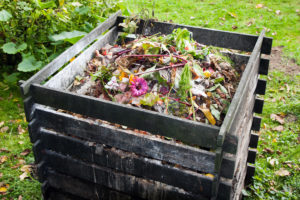30-40% of food in America is simply thrown away, and in a country where one in eight people suffer from hunger, this figure is particularly troubling. And yet the consequences of such wastefulness are not limited to humans, with the environmental impact of food waste on that scale also posing significant problems. When food waste becomes part of the stream of municipal solid waste (MSW) making its way to landfill, it becomes a potent threat to the planet. In the US, landfills constitute the third largest source of human-caused methane; a dangerous greenhouse gas 90 times more harmful than carbon dioxide.
As well as preventing unnecessary food waste in the first instance, Americans must learn to recycle unavoidable food waste in ways that benefit both people and the environment. The potential of composting to repurpose this dangerous waste stream into a nutritional fertilizer for the earth is significant. So too the promise of biogas engineered from food waste into a sustainable fuel for cars and electricity. At the core of effective handling of food waste is an understanding of when food becomes waste, because unfortunately much of the food being tossed out by American households is perfectly edible. What follows is a better comprehension of the food waste recycling options at our disposal.
Food Recycling Basics
Around 20% of food is thought to be wasted as a result of consumers misreading or misunderstanding date labels on packaging. Manufacturers are not required to include date labels on their products. They are used most often as conservative estimates of when the expected quality and flavor of a given food might begin to decline. These labels do not mean that the food has gone off or is even remotely past its best. However, many consumers still look at this date and toss something in the trash without a second thought.
The plethora of terms plonked on packaging by manufacturers makes it harder for consumers to navigate; “use before,” “sell by,” “expires on”, and more. This is why the FDA is attempting to standardize packaging around the phrase “best if used by”; to encourage a balance between seller guarantees of quality and consumer initiative. We need to learn to trust our own senses when it comes to our food. If it looks fine and smells fine, then it usually is fine. For those who can trust their own nose, foodkeeper app is available to help gain a better understanding of storing and disposing of food. So once you’ve established that something is no longer edible, what can you do?
Curbside Food Waste Pickup
Curbside organic waste pick-ups are available in some parts of the US, but not everywhere, and sometimes only by subscription. This is changing, with an uptick in food waste legislation winding its way toward law in almost every US state. For example, in January 2022 California made it mandatory for all jurisdictions in the state to offer organic waste recycling to businesses and households. New York followed suit with similar legislation, requiring businesses with more than two tons of waste must donate or recycle it.. In Vermont, a law restricting the disposal of food straps led to an incredible 40% increase in food donations from one year to the next, proving that wholesale changes can be put in place relatively quickly.
This legislative trend must continue if the country as a whole is to eat into the national issue of food waste ending up in landfill. But what if you don’t have food waste recycling services on your doorstep? Some businesses can contract waste management companies to assess their specific needs and arrange pick up services, but what of individual households and smaller businesses?
Food Donation 
Back in May 2022, RTS partnered with Rethink Food to rescue excess produce and provide meals to food-insecure families throughout the US. The programme’s impact is clear, and since the beginning of the COVID-19 pandemic, Rethink Food has distributed over seven million meals, seven days a week, across five cities (New York, Nashville, Chicago, San Francisco, Miami). This equated to some 1.2 million pounds of excess and/or donated food going to food insecure families.
Today, RTS offers clients the ability to send their excess food to Rethink Food, where it is transformed into nutritious and culturally celebrated meals at its commissary kitchen. Meals are then distributed by community-based organizations to food-insecure neighbors across the city.
However, even if you are not part of a larger donation program, households with excess food that you won’t use but it hasn’t yet gone off can still be donated. Domestic food scraps and leftovers are unlikely to be welcomed at most food banks and pantries for the simple reason that processing and distributing these foodstuffs safely and effectively is too arduous.
By and large, non-perishable goods are far more desirable than perishable food scraps. But while large not-for-profits like Feeding America accept regular corporate food donations from businesses through the mealconnect app, donations from private individuals are more complicated. The best course of action is to contact your local food banks directly and inquire as to their specific needs regarding types of food. Feeding America’s network of food banks can be searched by zip code to find the nearest location to your home.
FoodPantires.org provides a search engine for a more diverse network of soup kitchens, food pantries, and subsidized grocery stores who may accept a wider range of foods. The Food Rescue Locator is an indispensable tool in the fight to reduce food waste and combat hunger. The website boasts an interactive map of organizations that rescue, clean, prepare, and distribute food to those in need. These rescue organizations will collect food from private homes as well as restaurants and grocery stores. If you are moving house, Move For Hunger will take your excess food, combine it with others’ and make deliveries to food banks. But what can you do with the scraps of food and offcuts that food banks and rescue organizations won’t accept?
Composting
Composting keeps food from landfill and avoids generating harmful greenhouse gasses. It also returns precious nutrients to the earth when used as a fertilizer. In turn this reduces the soil’s need for synthetic fertilizers and improves its ability to retain carbon. A truly circular process: plants take in carbon when they grow and release it as they decompose. There are several home composting methods depending on your aims and kinds of waste.
Aerobic composting is the time-honored process undertaken in backyards around the world. It combines brown matter and green matter, and with the addition of oxygen, to encourage decomposition over a period of a few months. After which it can be dug into the soil to imbue the land with goodness. But exactly what food waste can be added to an aerobic compost bin?
Your green kitchen matter includes almost all fruit and vegetable scraps, just avoid heavily acidic peels from citrus rinds, and onion peels. And while plant milk is more than welcome, avoid dairy milk, cheese, and cream. Brown kitchen waste is everything from stale bread, dry pasta, and eggshells plus all the soiled papery bits like coffee filters, cooking parchment and food boxes – so long as there’s no plastic film around the paper. The other major don’ts are meat, fish, and bones – these can’t be broken down in aerobic bins. It will also pay to avoid baked goods and sugary items which could attract pests and scavengers, as well fats and oils, which disturb the balance of the pile and struggle to break down. Grains like cooked rice encourage bad bacteria and should be kept out too.
By contrast, in anaerobic composting the bin is sealed off from fresh air. This method can be undertaken with a bokashi compost bin at home. It’s an appealing method because technically there is no need for a backyard, at least for the initial phase of fermentation. The closed-lid system also means that odors are more easily contained, meaning it can sit comfortably inside the house. But perhaps the biggest advantage of bokashi composting is the wider range of foods that can be added on top of those used in aerobic composting; including meat, dairy and small bones. For households who have no organic waste collection, this could be the difference between food waste heading for landfill, and safe diversion. Full disclosure: the bokashi process requires the addition of a special “bran” used to kick start fermentation, and a piece of land in which to bury the resulting “pre-compost’. If you want to keep the compost for yourself that is. Otherwise, use this national compost locator engine to find a drop off site.
Vermiculture (worm farms) is a faster, more self-sufficient process than the other two mentioned, and yields a higher quality compost ready for use. Worm farms can also break down meat, fish, and dairy effectively. Despite these benefits, the worms are rather expensive and if not fed properly are vulnerable to death. Plus, not everyone is ready to welcome worms into their home quite yet.
Finally, for those seeking a foolproof solution for composting their kitchen waste, and who have a budget to play with, a countertop food recycler will take care of the entire process from food scrap to soil-ready fertilizer. One manufacturer’s assertion that their product emits 54% less CO2 than an outdoor aerobic compost bin is impressive and renders this option a rather environmentally friendly one.
What Is Really Compostable?
An important caveat to composting as a household or a business is that some food packaging labeled “compostable” or “biodegradable” may not be compostable at home. This is a lamentable source of confusion, often left unstated on packaging, which inevitably leads to compostable packaging being sent to landfill to emit greenhouse gasses. The crux of the issue is that as bioplastics made from natural materials (e.g. hemp, bamboo and corn) have emerged as alternatives to fossil-fuel based plastics, manufacturers have been permitted to overstate the green credentials of their products. But the truth is that while many of these bioplastics are compostable, they usually require the specific conditions of an industrial facility to break down. One of the few types of bioplastics that can break down in an aerobic compost heap is made of algae (think seaweed).
Food Recovery Hierarchy
It’s worth remembering that there are four preferable steps before composting on the EPA’s (Environmental Protection Agency) Food Recovery Hierarchy. For example, we should first look to reduce the source of food waste and redirect it to those humans or animals in need of it before composting, i.e. through the donation steps discussed above. It is also preferable to funnel certain waste streams toward industrial uses before composting them yourself as a business or household. Case in point; in an industrial anaerobic digester, as opposed to the bokashi bin described above, the methane gas from fermentation can be converted into biogas for running alternative fuel vehicles, among other applications. Although composting is a carbon neutral process, we can see how capturing the greenhouse gasses released during decomposition is preferable to the impact of a home anaerobic composter, in which those gasses escape.
If you want to learn more about responsible waste disposal and how your business can begin increasing diversion rates, then contact our TRUE advisors today to discuss your requirements and learn more about how to develop a healthier relationship with waste by subscribing to the RTS blog.

